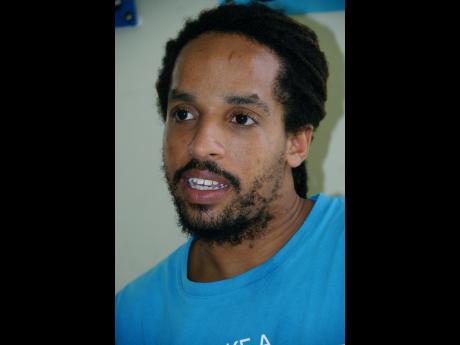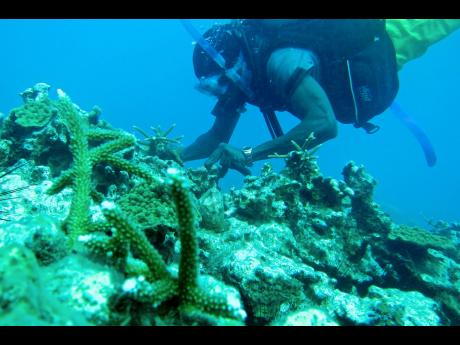Feeding from the Sanctuary
It has taken some doing and is still a work in progress, but the fisherfolk in and around the seaside community of Oracabessa, St Mary, are beginning to understand and appreciate the potential of the Oracabessa Bay Fish Sanctuary to improve their lives and livelihoods, as well as that of their children and grandchildren.
Officially established by the Government in 2011, the need for a sanctuary was recognised at least a decade earlier as some far-sighted fishers began to realise that the fruits of their labour were dwindling.
"A fi wi thing long time before the Government even have that interest because we as fisherman see the need because the place fish out. We see that 15 years ago, before Government came into it, and we had wanted to set up like a marine park suppen before the Government start to deal with this," said David Murray, president of the Oracabessa Bay Fisherman Co-operative Union.
Now Jonathan Gosse, executive director of the fish sanctuary, is reporting that the size of the fish has increased by 102 per cent on average, fish density or the amount present has gone up by 300 per cent, coral coverage has improved by more than 153 per cent, with algae down by 47 per cent.
"The key thing now is this, between May 2011, when NEPA (National Environment and Planning Agency) did our baseline study because we were just starting, and May 2014 we've had a 1,313 increase in biomass. Fish biomass is basically grams of fish per square metre, so whether there is a lot of fish or a few big fish it's a 1,313 per cent increase," Gosse told The Sunday Gleaner during a recent visit.
"The parrot, they eat the algae, and when you got more of those, you got the snappers back which are the meat-eating fish. Right now out there are snapper bigger than you have ever seen in your life, probably, and they are not afraid of people because they are not getting chased," continued Gosse.
Impressed by the changes
Martin Fannell and his girlfriend, who joined him in fishing more than 10 years ago, were just returning to shore when the our news team visited and she was very impressed with the changes in the area designated for the sanctuary.
"It working, you can see fish in it. It working, man, this should have been done 25 years ago so we woulda have more fish. It is a benefit because fish breed up back inna yah nice and you can see fish," she declared in an assessment of the situation.
Randal Scott, who has been fishing for more than 30 years, was one of the wardens on duty and spoke about the benefits of the changing reality which most people in the area have come to recognise.
For him, the decision to "give away" the designated section of the sea wasn't difficult since it was not an area suited for pot fishing. Scott charged that even though the area had been overfished, some spearfishers and others using nets still plague the area.
"The spearfishers, now and then, will try to violate because them find out seh nuff fish in deh. Because days gone you never used to see no fish at all there and now when you are there scaling fish, a fish a come pick you hand and ... the size fish weh we see now we no see them fi years."
Among the converts is a Mr Senior who still does spearfishing but in a much more responsible way, especially since he is among the select group of wardens.
"Me a spearfish about 17 years before the sanctuary start around here because me dive the whole a them place here. Me naw tell no lie, it was graveyard, now fish a gwan," admitted Senior, even as he indicated that he will continue his spearfishing.
"We neva have no choice. If you search round you could a lucky enough fi find one big barracuda but nothing, not even small fish, but from the sanctuary come round you start see a lot of fish. So the fish them a come back now so you can realise seh it a work. It a work. Any how it did start 10 years ago we would have more fish now ... is a good thing, real good thing," continued Senior.
"The sanctuary is a good thing. People fi just admit it and give it a chance. It a work and you see result now, if you round there you think is a aquarium - snapper, grouper, lobster, everything, it a work, man!"
Executive Director Gosse and Manager Inilek Wilmot are well aware that the fight to keep the sanctuary going has only just begun, and they know the importance of understanding the dynamics of maintaining balance between the intangibles.
"What we've really been good at is taking that Jamaican sense of this is our turf and turning it from you can't tell us what to do and turning it into something a bit more positive. And that's all about trust and power.
"The biology is in there and it's important and all that, but it's really about trust and working together and working through all of the ups and downs and the tomfoolery and the skulduggery," said Gosse.
For Wilmot word-of-mouth testimonials from the very people who were among the most serious offenders is a very effective public education tool.
"Each person has a network of friends, fishermen that they have conversations with, and now they are on the sanctuary site, so each person there you see is really winning over maybe 15 other persons."





